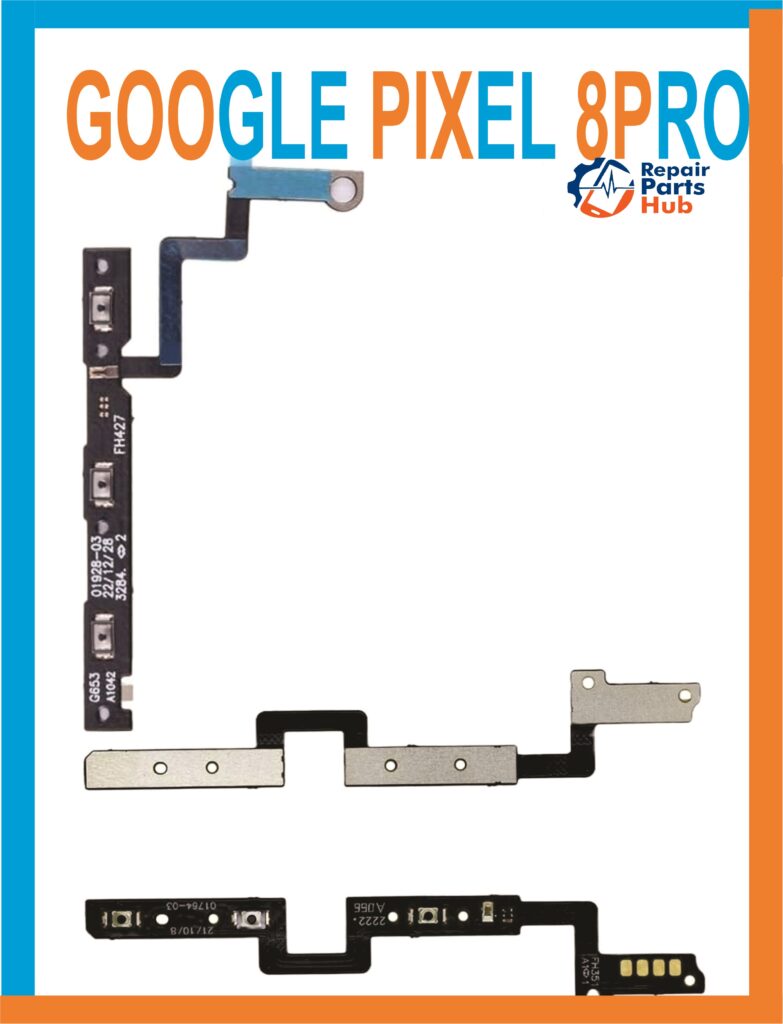
Google pixel 8pro power flex and volume flex is one of the internal component of pixel 8pro or the small flex cable with connectors as it looks like 1024×1024 in size.
The google pixel 8pro power flex and volume flex is the small internal flex cable that is responsible for the powering the engine on, It is also responsible for controlling the device volume, regulating sounds, vibration, silence and mute button.
While the powering button is responsible for the phone rebooting and phone power on and off, when you long press it you can see reboot option power off option emergency option. If you hold power button and hold volume button, you can see options like reboot, factory reset, change languages, flight mode, and emergency mode.
Introduction
In modern smartphones, many of the physical buttons are sometimes camera shutter or for mute button is connected from the flex circuit these are thin, bendable ribbon like circuits that carry the electrical signals from the button assembly to the motherboard.
In Google pixel phone and many other phones, the volume and power flex wire is complicated internal component. If it spoils or fails down or damaged, you may lose the capacity to turn the device on or power it off or even adjust the volume set. Because the flex wire is internal, repairing and diagnosing process requires opening the device sometimes beyond casual.
In this blog I will explain
- Diagnostic steps
- How it is integrated
- What exactly the power or volume flex for the pixel 8 pro
- How to source parts, how difficult or risks
Pixel 8 pro hardware context
This blog will help you understand where the flex stays and the challenges that occurs
- The pixel 8 pro is powered by Google’s Tensor G3 chip 4nm and it also runs Android 14 and it is also upgradable.
- The phone is produced with premium package with aluminum frame, glass front and back and some degree of water dust resistance
- However, thepower and volume flex cable is a replaceable part in many aftermarket and repair part catalogs.
- Because of the compact internal design, many components are tightly packed, and flex cables must thread through narrow spaces.
- The charging USB‑C port is soldered to the motherboard, making that
What is the power and volume flex?
The power or volume flex is also called button flex or power flex cable, is a flex printed circuit or a ribbon that connects the physical button module and the power key, and volume key up and down straight to the main board through a connector or solder pad.
In the pixel 8 pro, this flex typically includes both the power on and off sleep and awake and volume up and down, power and volume button for Google pixel 8 pro.
The flex is connected inside the side frame of the phone beside the bezel frame edges to reach the logic board, passing under or beside other component like midframe, shielding and more.
because of the location, the flex is subjected to mechanical stress bending wen opening or closing the complete phone housing, if the user press the button hard or repeatedly, even when the phone dropped or bent.
Common symptoms or failure modes

When the power or volume flex is broken or degraded, you might see one or more of these symptoms
| Symptoms | Description | Possible issue |
|---|---|---|
| Power button doesn’t work or respond well, only in some position | Pressing power button gives no reaction no wake no shutdown | Trace broken, flex crack connector loose |
| Intermittent behavior | button work sometimes | flex partially delaminated intermittent connection |
| Button feels loose and shaking | physical loosening of button mechanism | Retaining clips or housing loose |
| Noise or crackle when pressing buttons | Audible crack or static when pressing | Broken trace, brittle flex and intermittent conduction |
| Device is not powering on | check the battery or other faults | could be external, but flex is a suspect if nothing else works. |
| volume up and is not responding | Volume keys unresponsive | could be the flex or button contacts failing |
From some users reports, some Google pixel 8 pro units always have power button issues out of the box. only the lower half of the power button work.
These suggest that in some production units, tolerances or assembly problems may lead to flex or interface issue. Because the flex is internal, it is not always obvious to the users when it is failing occasional unresponsiveness or jitter might be mistakenly attributed to software.
Risk of replacement
Replacing a button flex in a modern flagship like the Pixel 8 Pro is not trivial. Risks include:
- Adhesive removal and reapplication the back cover, mid frame, and other interior parts are often secured with strong adhesive. Removing them without damaging glass, camera module, NFC or charging coils is tricky.
- Routing and alignment the flex must be routed exactly in its intended path, avoiding tight bends, sharp corners, and interference with other components.
- Connector and socket damage, if the flex plugs into a small board or connector on the main logic board, mishandling may damage the socket or board.
- Dust and debris intrusion, during reassembly, small particles may enter and cause shorts or degrade electrical contact.
- Warranty void and irreparable damage Opening the device yourself may void warranties or irreversibly damage components like display, cameras.
Because of these factors, many repair professionals regard this as a moderate difficulty job.
The Outline
Below is a high level outline of what a repair might involve for a competent technician:
- Power off device, remove SIM tray.
- Use heat or adhesive softener to loosen adhesive around back cover.
- Carefully pry off back cover taking care of wireless charging or NFC coil adhesives).
- Remove screws or shields from mid frame to get access to internal modules.
- Locate and gently detach old power and volume flex from connector or remove solder.
- Remove old flex, clean any residue or adhesive.
- Place new flex, route it exactly. Connect it securely.
- Reassemble, reapply adhesive and seals properly.
- Test buttons immediately before full reassembly.
- Final reassembly, check for alignment, tightness, sealing water or dust.
If possible, testing before full glue down helps catch mistakes early.
Cost & Time
- The part cost for a replacement flex is often modest maybe several dollars to a couple tens depending on region and quality.
- The labor and risk may be the larger cost factor.
- In some regions, repair shops quote a fixed button flex replacement rate.
- Some users attempt DIY, but success depends much on one’s skill and tools.
When to Let a Professional Handle
If you are not comfortable opening phones or working on small electronics, it’s safer to entrust a repair shop. They will have proper tools microscope, spudgers, and adhesion materials and experience.
Preventive Tips & Best Practices
To maximize the longevity of the power and volume flex and reduce risk of failure:
- Avoid unnecessary opening or disassembly every open or flex bending is a chance to weaken the cable.
- Don’t force buttons Avoid pressing buttons too hard or using the edge of a fingernail.
- Protect from impact or bending drops Structural stresses can flex internal components.
- Quality cases & bumpers A well-fitting protective case can reduce shock to the frame and internal flexes.
- Humidity or moisture avoidance Moisture ingress can degrade flex adhesives or cause corrosion.
- Gentle repairs only if opening for other repairs battery, screen, be extremely careful routing the flex.
Conclusion
The power and volume flex cable in the Google Pixel 8 Pro is a small but critical internal component. When functioning properly, it is invisible and reliable. But when it fails due to mechanical stress, flex fatigue, connector loosening, or manufacturing defects the user can lose vital functionality turning the phone on or off, adjusting volume.
Because it is internal and sensitive, proper diagnosis and replacement require care, skill, and the right parts. That said, the fact that many repair parts catalogs list compatible flexes is a hopeful sign that this component is serviceable (though with effort). For users, being gentle with the phone, avoiding harsh impacts, and using well-fitting protective gear are good preventive measures.